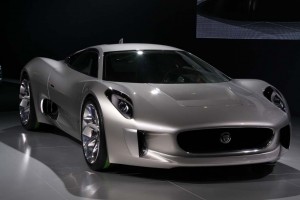
Jaguar has killed the closely-watched C-X75 supercar project but hopes to reuse some of its technology.
Jaguar has decided to cancel production plans for the high-tech C-X75 supercar, contending that it is “the wrong time” to bring out a vehicle that could push upwards of $1.5 million considering the current global economic situation.
The C-X75 concept won wide praise for both its design and technology when it debuted at the 2010 Paris Motor Show. Several months later, Jaguar officials announced plans to produce the plug-in hybrid, albeit replacing the show car’s twin turbine generators with a more conventional internal combustion engine.
Despite nearly two years of development, the program has now been nixed, Jaguar’s global brand chief Adrian Hallmark told Britain’s Autocar, though five running prototypes will be completed by May 2013.
“We feel we could make the car work, but looking at the global austerity measures in place now, it seems the wrong time to launch an £800,000 to £1 million supercar,” Hallmark told the magazine. “This is backed up by other products from us that people are screaming out for.”
In a separate interview with TheDetroitBureau.com, Hallmark has indicated the British maker has on the order of 40 other product and powertrain projects in the works, including the upcoming F-Type and the C-X16, another plug-in vehicle.
The more exotic C-X75 was to have featured a bonded carbon fiber chassis developed in cooperation with the Formula One racing team Williams. There were to be two electric motors, one at each axle, drawing power from a lithium-ion battery pack.
The system was designed to permit driving in electric only mode – for as much as 60 miles — and, much like the Chevrolet Volt, when the batteries are run down power would continue to be delivered to the wheels through electric propulsion. The 1.6-liter gasoline engine onboard would have been used solely to generate electricity, not to provide direct torque to the wheels.
The system was expected to generate an awe-inspiring 888 horsepower and 590 lb-ft of torque and deliver very un-Volt-like acceleration that was expected to yield 0 to 60 times of around 2.8 seconds, with top speeds reportedly nudging 200 mph.
All is not for naught, Hallmark said. Jaguar will still produce those five running prototypes and as many as three may be sold at auction. It would like to keep one for running demonstrations and place the fifth C-X75 prototype in the Jaguar museum.
Meanwhile, Hallmark suggested “60%” of the technology developed for the C-X75 project will still find application in other Jaguar programs, including a possible downsized version of the hybrid drivetrain.
While there’s little doubt global economic issues have curbed the appetite for million-dollar automobiles, Jaguar reportedly had received preliminary “expressions of interest” from 100 possible customers for the C-X75. The maker had planned to cap production at 250.
Jaguar’s sensitivity to demand for high-end supercars is understandable for several reasons. First, it is trying to stretch its budget as far as possible as it tries to rebuild a brand that had faded in recent years. It needs put the focus on propping up sales that have declined sharply compared to competitors like BMW, Audi and Mercedes-Benz.
There’s also the troubled XJ-220 project to keep in mind. That mid-1990s supercar was also supposed to provide a halo for the brand but instead proved to be a fiasco when the luxury market dried up and Jaguar was left struggling to sell all the XJ-220s it had built. Clearly, the maker was not looking to repeat that mistake.

“The C-X75 concept won wide praise for both its design and technology when it debuted at the 2010 Paris Motor Show. Several months later, Jaguar officials announced plans to produce the plug-in hybrid, albeit replacing the show car’s twin turbine generators with a more conventional internal combustion engine.”
Does it say:
The Press ‘praised” Jaguar
“for its technology”
“when it debuted at the 2010 Paris Motor Show” ?
Does it say:
“albeit replacing”
“the show car’s TWIN TURBINE generators”
“with a more CONVENTIONAL internal combustion engine” ?
Won’t be interesting to know ?
How many LETTERS, from ACROSS the WORLD
Told (WROTE) Jaguar ?
that the old CONVENTIONAL engine IS now TOO good …?
is NO longer what it USED to BE ?
what Jaguar’s “twin Turbine” TOY
can DO in the FACE of a DIGITAL engine ?
http://www.pattakon.com/pattakonHydro.htm